Understanding Qualcomm's Snapdragon 810: Performance Preview
by Joshua Ho & Andrei Frumusanu on February 12, 2015 9:00 AM EST- Posted in
- SoCs
- Qualcomm
- Mobile
- Gobi
- Snapdragon 810
GPU Performance
Last but certainly not least, we have GPU performance. As we mentioned earlier, the Snapdragon 810 introduces Qualcomm's Adreno 430, the latest member of the Adreno 400 GPU family. Qualcomm's own performance estimates call for a 30% increase over Adreno 420, with a final GPU clock of 600MHz being identical to the Snapdragon 805's (Adreno 420) own GPU clock speed.
From an architectural standpoint Adreno continues to be something of a black box for us. Other than being a modern OpenGL ES 3.1/AEP design, we don't know too much about how the GPU is laid out, and Qualcomm's current legal battle with NVIDIA likely not helping matters. In any case, Qualcomm has indicated that Adreno 430 is not just a simple extension of Adreno 420, so we may be looking at an architectural change such as wider shader blocks.
For today's benchmarks, as we mentioned before we only had a limited amount of time with the Snapdragon 810 and had issues with BaseMark X. We've had to pare down our GPU benchmarks to just 3DMark 1.2 and GFXBench 3.0. Once we get final hardware in, we will be able to run a wider array of graphics benchmarks on Snapdragon 810.
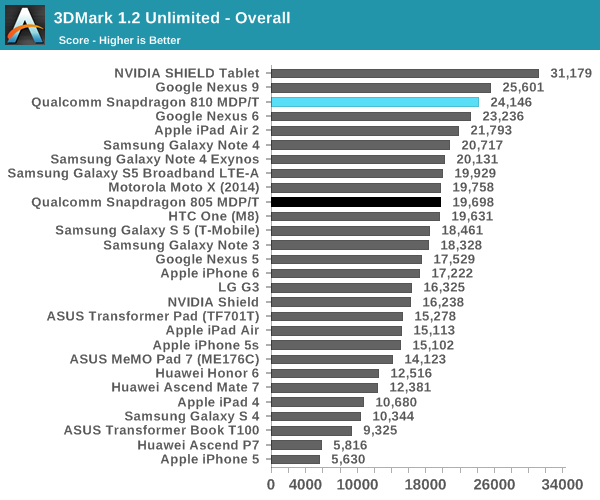
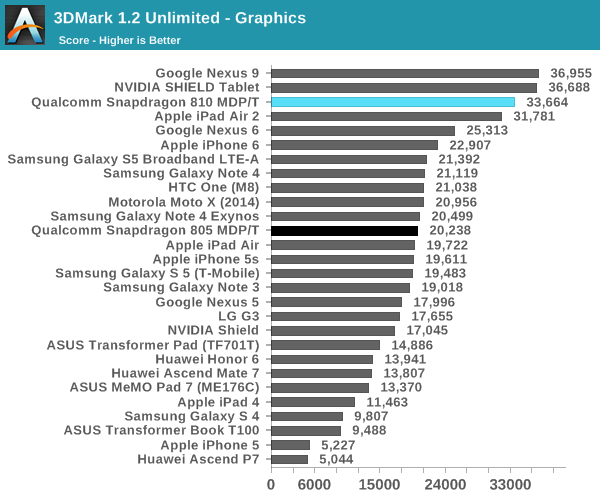
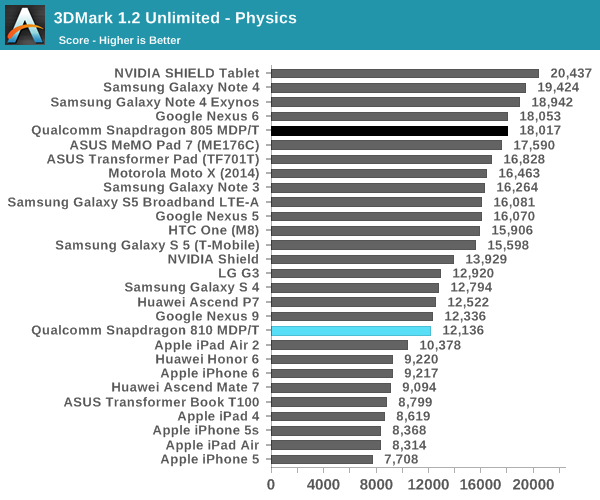
Starting off with 3DMark, compared to the Snapdragon 805 reference platform the actual graphics performance advantage is even greater than 30%, coming in at closer to 65%. However since drivers play a big role in this, a more recent 805 platform like the Nexus 6 may be a better comparison point, in which case the gains are 33%, just a hair over Qualcomm's own baseline performance estimate. We also find that Snapdragon 810 oddly struggles at physics performance here, underperforming Snapdragon 805 devices, something the Exynos 5433 didn't have trouble with. As a result overall performance is only slightly improved over the Nexus 6.
Continuing with GFXBench, we look at more pure GPU loads. One has to take note that the MDP/T employs a 4K screen resolution, and the on-screen results will likely suffer from that.

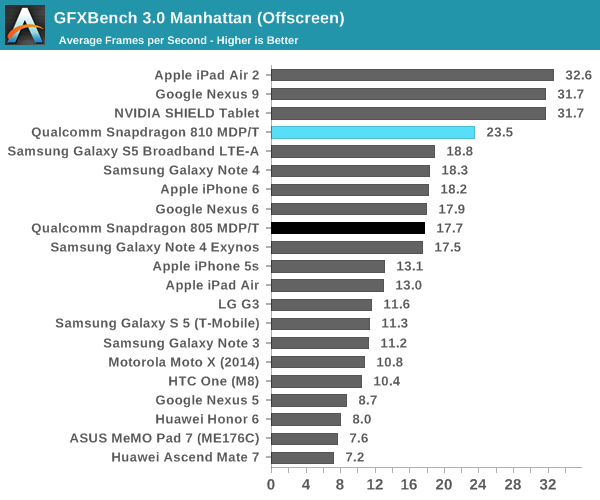
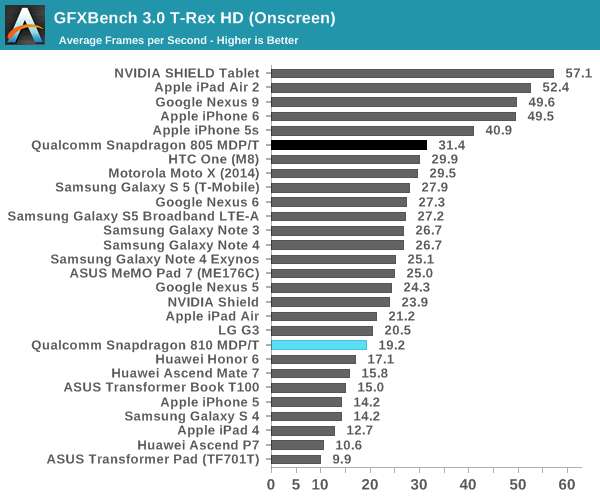
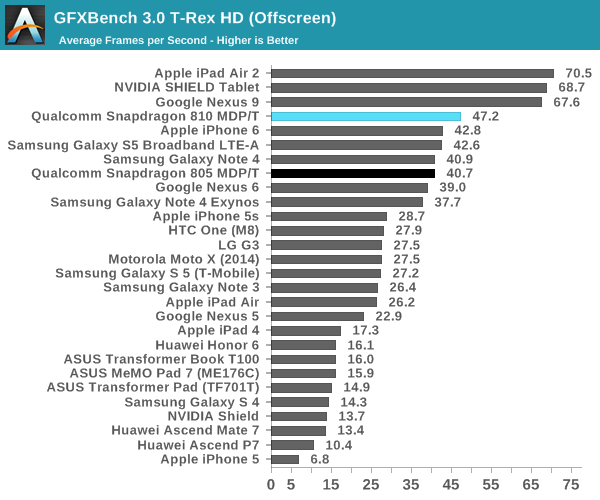
Under GFXBench 3.0's full rendering tests of Manhattan and T-Rex, the Snapdragon 810 continues to show considerable performance gains over the Snapdragon 805. Ignoring the onscreen results for now since the Snapdragon 810 reference platform runs at such a high resolution, offscreen results show the 810 outperforming the 805 by 33% in Manhattan and 16% in T-Rex. The former is again well in-line with Qualcomm's performance estimate, wile the older T-Rex benchmark doesn't show the same gains, possibly indicating that Adreno 430's biggest gains are going to come from shader-bound scenarios.
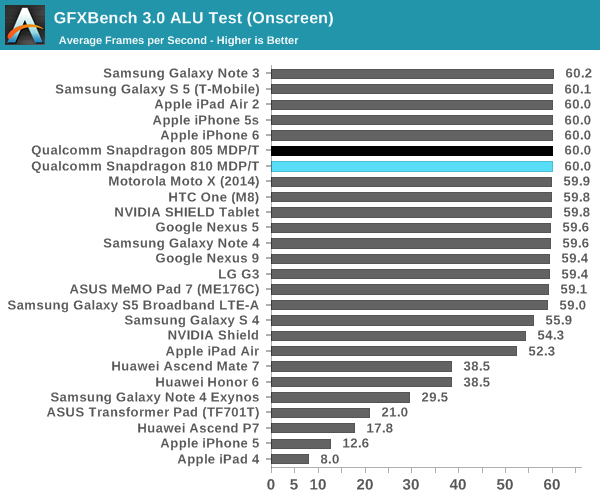
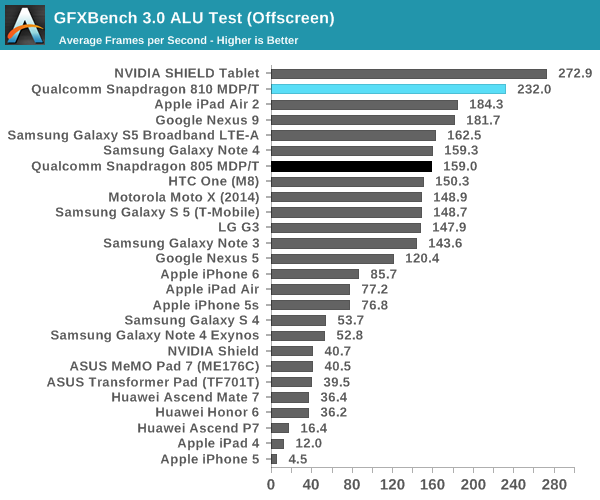

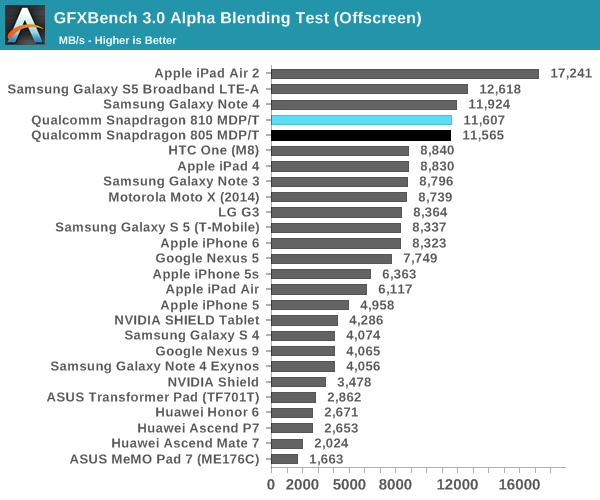
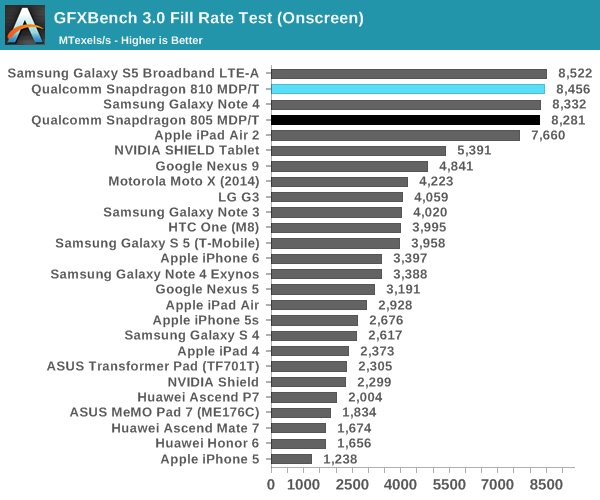
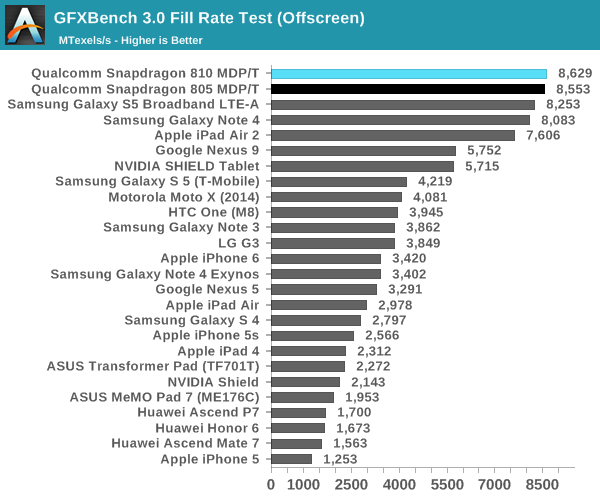
Meanwhile GFXBench's synthetic tests continue to put Adreno 430 and the Snapdragon 810 in a good light. ALU performance in particular is showing very large gains - 46% better than the Snapdragon 805 and Adreno 420 - while our blending and fillrate tests show almost no gain over Snapdragon 805. This adds further credence to our theory that Qualcomm has widened or otherwise improved Adreno's shader blocks for 430, as other elements of the GPU are not showing significant performance changes.
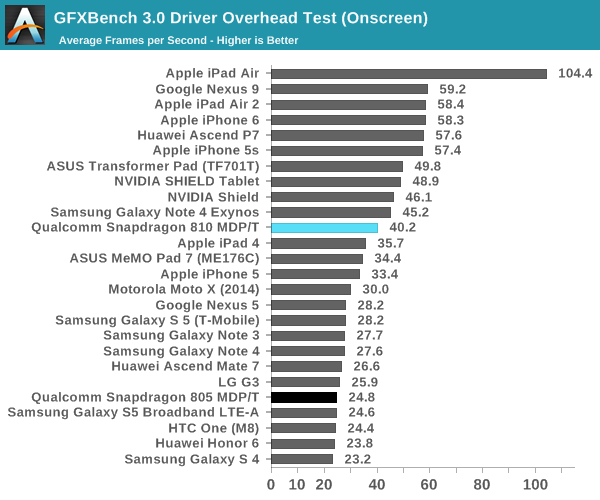
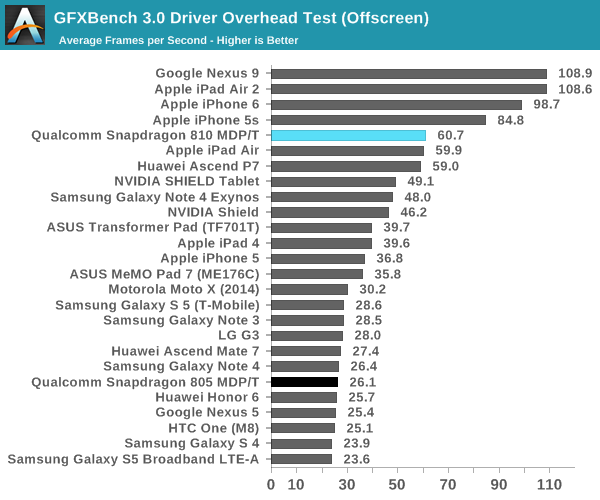
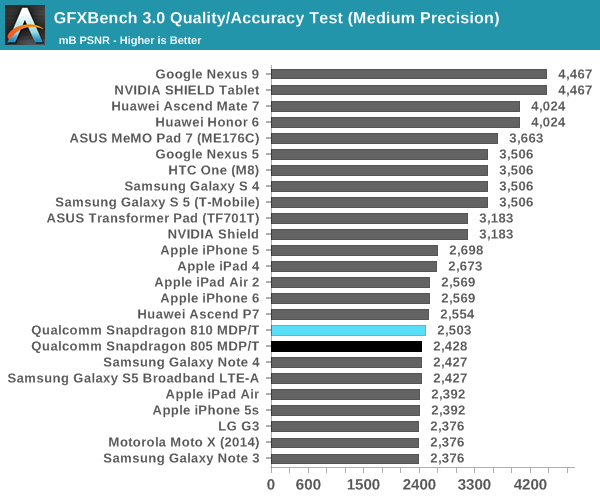

Finally, GFXBench's driver overhead and accuracy tests are more or less what we would expect for Snapdragon 810. In the case of driver overhead, a combination of newer drivers and a much faster CPU have reduced the CPU cost of driver overhead. Meanwhile with the underlying GPU architecture being unchanged, there are no material changes to quality/accuracy.
Overall then the performance gains for the Adreno 430 and Snapdragon 810 seem to be almost exclusively focused on shader performance, but in those cases where rendering workloads are shader bound, Qualcomm's 30% estimate is on the mark. Real-word performance gains meanwhile are going to depend on the nature of the workload; games and applications that are similarly shader-bound should see good performance gains, while anything that's bottlenecked by pixel throughput, texturing, or front-end performance will see much smaller gains. Thankfully for Qualcomm most high-end workloads are indeed shader bound, and this is especially the case when pushing high resolutions, as Qualcomm is trying to do with their 4K initiative for Snapdragon 810. However in the case of 4K, while Adreno 430 offers improved performance it's still slow enough that it's going to struggle to render any kind of decently complex content at that resolution.
As for Adreno 430 versus the competition, Qualcomm has narrowed much of the gap between themselves and NVIDIA/Apple, but they haven't closed it. Apple's Imagination GX6850 and NVIDIA's K1 GPUs continue to hold a performance advantage, particularly in GFXBench's Manhattan and T-Rex full rendering tests. Both Apple and NVIDIA invested significant die space in graphics, and while we don't know how much Qualcomm has invested in Adreno 430 with Snapdragon 810, it's safe to say right now that they would need to invest even more if they want to beat the graphics performance of NVIDIA and Apple's tablet SoCs.










119 Comments
View All Comments
Laststop311 - Friday, February 20, 2015 - link
Also forgot to mention with the less heat generated from backlights not needing to be as strong this also gives more thermal room to the SoC so doesnt have tp throttle at all or in less situations.Antronman - Saturday, February 14, 2015 - link
It's all about the buzzwords.The last year or so, "4k" and "UHD" have been the buzzwords. If it's sub 3k, it isn't acceptable. 4k is decent. In two years people will be complaining about a lack of 8k panels.
Wwhat - Sunday, March 15, 2015 - link
People put them in VR headsets, and then resolution is never enough.open4g - Wednesday, March 18, 2015 - link
One factor driving 4K onto SmartPhones, Phablets and tablet small-screen devices will be miracast and entertainment stations. I don't think 4K will be what sets the majority of consumer expectations for mobile devices for another 3-4 years. By that time SoCs should be manufactured using smaller geometries that reduces power consumption for H.265 by 25%-50% compared to the first generation HEVC capable mobile chips. And there should be more available content.There are limits to human visual acuity on small screen devices that 4K buts up against. What will eventually be needed is partly anticipated by dual-camera GPU, particularly the encoding. This can enhance perceived resolution on small screens. Its a topic for another discussion.
Nandy - Saturday, February 14, 2015 - link
You'll need the highest resolution you can get if you use VR.leliel - Thursday, February 12, 2015 - link
On a five foot display? Yeah, it helps.Now if we're talking 5"... I've used 480x800 and 1080x1920 phones for an extended period and I suspect even current screens like the latter are borderline overkill. 720x1280 might have been the sweet spot for performance/battery. 4K is definitely a negative feature in my books.
SilthDraeth - Thursday, February 12, 2015 - link
If I could upvote you, instead of replying I would have. LOL the 5' vs 5" comment is priceless.Notmyusualid - Thursday, February 12, 2015 - link
Yes, for the love of the Lord - please switch to Disqus already!Allows us to edit / delete comments too...
And I believe, (mistakenly?), it is free too.
YUGogo - Friday, February 13, 2015 - link
I'd say 1080p will do just fine on a performance-battery ratio. I'm ok with 720p atm (I use a Blackberry Z30), but I can see its limitations compared to 1080p. While not everyone can, (the whole "retina display" thing), 20/20 vision isn't actually "perfect" and there are other measures to vision beyond that. The day AA is no longer needed is the ideal resolution. The one arc thing at 12" being maximum is false. It's not uncommon for humans to go as low a 0.3 degrees at 12" for that form of acuity. 2160p is "sufficient" for almost any human. But I'd be very happy with "just" 1080p for phones. I don't want to need a 4000mAh battery just to last the day.Uplink10 - Friday, February 13, 2015 - link
That is what they ususally do, phones (the ones from LG, Samsung, Motorola...) get better battery but they also get higher resolution and in the end you are a little better off instead of a lot. Droid Turbo has 3900 mAh battery but comes with 1440p display.